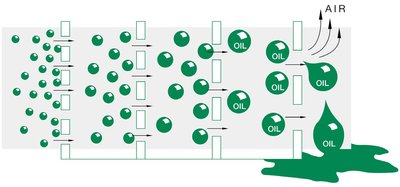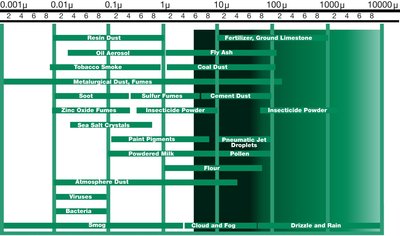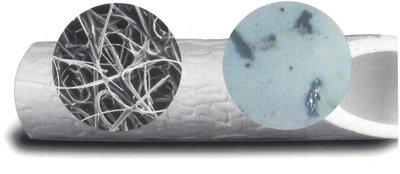Filtration system design: key to improving pneumatic performance
In an ideal world, industrial air or gas supply lines would be free of particulate, water, oil and other contaminants. In the real world, however, supply lines typically deliver some contaminants along with the air or gas they were designed to carry.
Efficiency losses, maintenance headaches and the premature failure of pneumatic components are all possible if contaminants are left unchecked in an air or gas supply.
Filtration systems are an easy way to clean up an air or gas supply - these systems employ one or more filters to remove contaminants before they reach the pneumatic equipment. But selecting the right type of filtration system for a particular application is not so easy.
The difficulty partly comes from the different filtration requirements across industries. Food and beverage, semiconductor and automotive plants, for example, all have different filtration needs based on their specific pneumatic systems and operating environments.
The difficulty in choosing the right filtration approach also involves differences in the filters themselves. Not all filtration technologies are created equal in terms of their intrinsic performance characteristics and suitability to a given application. Choosing the wrong filter or applying it incorrectly can actually do greater harm than good.
To tailor filtration systems to the job at hand, it’s important to understand not only the capabilities of different filter elements but also how to combine them in series.

Filter types
Effective air filtration starts with an understanding of the different types of filter media and what they can do. The most common types used in industrial settings include water separators, particulate filters, coalescing filters and adsorbing filters.
Water separators
Water or moisture can quickly damage pneumatic components, causing valves and cylinders to stick. Water separators use the centrifugal forces generated by an internal spinning mechanism to remove large quantities of water and water-borne contaminants. While typically used to remove bulk liquids and large water-borne solids, water separators also protect other filter elements from large liquid loads that could shorten filter life.
Particulate filters
Large particles such as rust, debris and desiccant dust can wear out pneumatic components prematurely. These contaminants are often generated by old carbon steel pipes, compressor intakes and desiccant air dryers. The best particulate filters feature pleated designs to maximise the surface area available to trap dirt particles. Particulate filters are often used to achieve up to a 3-micron particle removal in dry systems.
Coalescing filters
Coalescing filters are the next line of defence in an air filtration system and can do a good job removing water, oil, rust and other contaminants from the air supply. The design of coalescing filters differs from manufacturer to manufacturer. The Numatics Delta Series coalescing filter elements, for example, consist of a porous network of borosilicate glass fibres. As air moves through the filter element, solid particles are trapped and liquids are formed into droplets that drain away.
Coalescing filters come in different grades. Coarse coalescers are often used for mainline plant filtration, while fine coalescers are used for applications such as paint spraying, robotics and pneumatic tools. The ultrafine coalescer is mainly a point-of-use filter specified for critical processes such as semiconductor packaging and instrumentation.
Adsorbing filters
As a final step in certain applications, an adsorbing filter may be added to remove oil and hydrocarbon vapour from the compressed air stream. This type of filter is used immediately downstream from a coalescing element. Because optimum adsorption takes place at lower temperatures, it’s best to install the filter as close to the point of use as possible. Adsorbing filters are often used for breathing air preparation as well as food and drug applications that have direct product contact with exhaust air.

Filter design and construction
While these common filter types are sometimes referred to generically, keep in mind that there are substantial quality and performance differences between filters from different sources - even if they have the same nominal filtration specification. These differences often boil down to design and manufacturing methods.
Coalescing filters are a prime example of why design and manufacturing matters. Commodity coalescing elements typically employ a mechanically wound filter media, but quality and performance can be dramatically improved by employing a vacuum-formed filter media composed of glass fibres and an epoxy binder.
This manufacturing difference is not trivial. The vacuum-formed design traps contaminants through the entire cross-section of the filter. The result is a lower pressure drop and more capacity than a comparable wrapped filter that traps contaminants primarily on the surface and quickly clogs as a result. Filters with the vacuum-formed design have an initial pressure drop of just 1.5 psi in a dry condition at rated flow - far lower than a typical wrapped filter.
Vacuum forming also allows the customisation of filter element recipes to achieve desired filtration levels. Filter engineers can tweak the vacuum-forming process to an extensive range of gradient densities to form coalescing elements ranging from 0.01 to 1 micron.
Construction differences apply to other filter types too. The Numatics Delta Series adsorbing filters, for example, consist of fine activated charcoal impregnated on polyester. These activated carbon particles have a strong affinity to vapour and are highly efficient due to the extensive surface area present.
Effective filter combinations
Most filtration systems require multiple filter elements, working together to remove the full spectrum of particulate sizes and compositions capable of harming downstream components. The specific combination, or series, of filters will vary depending on the application’s air quality requirements.
Food and beverage or semiconductor applications, for example, may require three different filters, including ones capable of removing submicron particles. Others such as main line plant filtration may require just a coarse particulate filter. Here are a few examples of filter combinations used in various applications:
- Blow moulding: 3-micron particulate filter; 0.01-micron fine coalescer; vapour adsorber.
- Electronics: 3-micron particulate filter; 1-micron coarse coalescer; 0.01-micron ultrafine coalescer.
- Food packaging: 3-micron particulate filter; 0.01-micron fine coalescer; vapour adsorber.
- Pneumatic control systems: 3-micron particulate filter; 0.01-micron fine coalescer.
- Process air: 1-micron coarse coalescer; 0.01-micron fine coalescer; vapour adsorber.
- Semiconductor packaging: 3-micron particulate filter; 0.01-micron fine coalescer; vapour adsorber.
Bear in mind that combinations of filters do not always require separate products. In some cases, different filter elements can be combined, saving space and simplifying the ordering process. Numatics Delta Series coalescing filters, for instance, have a pleated 3-micron pre-filter available as an option, which can eliminate the need for a separate coarse particulate filter. This two-in-one approach saves both space and money because the prefilter can share the same housing with the coalescing filter.

Filtration is part of a system
Too many machine builders and installers fail to consider air filtration. Or if they do, it’s just an afterthought. Filtration’s biggest benefits, however, come when the air filter and pneumatic components work together as a system. Only then will the filter offer the maximum protection against contaminants while preserving pneumatic efficiency.
Matching the filtration technologies with specific pneumatic system can be daunting. So it’s helpful to seek out an experienced filtration supplier who can help strike the right balance between air quality and pneumatic system performance.
Industry spotlight: Proper filtration solves mouldy bread dilemmaFood and beverage processing requires compressed air filtration to protect not just the pneumatics but also the product. Recently, a large commercial baker discovered that air filtration is an important ingredient in its bread making operation. When trying to reduce unacceptable mould levels in the compressed air lines at the plant, the baker’s process engineers discovered that the compressed air used to inflate bread bags and blow away the grains after the slicing process was also injecting mould spores drawn in by the compressor. A 5-micron filter had been installed on the air supply, but this level of filtration does not stop mould spores. To solve the problem, a series of three filters were added to the compressed air supply - a particulate filter to remove water and large particles, a 0.01-micron coalescing filter to eliminate the spores and other ultrafine particulate, and a vapour-adsorbing filter to remove any oil or hydrocarbon vapour. After adding these filters, lab tests confirmed that the mould spore count has been significantly reduced, extending the bread’s shelf life. This three-filter solution is now being evaluated as a standard for all machines across the company’s global baking facilities. |
Use your energy twice
Heat recovery can significantly increase the efficiency of a compressed air system and reduce...
Greater efficiency with centralised compressed air control
Weidmüller improved its compressed air system performance by integrating the control of five...
Finding the ice cream packing sweet spot
RML Machinery recently partnered with SMC Corporation New Zealand on the design and build of a...







